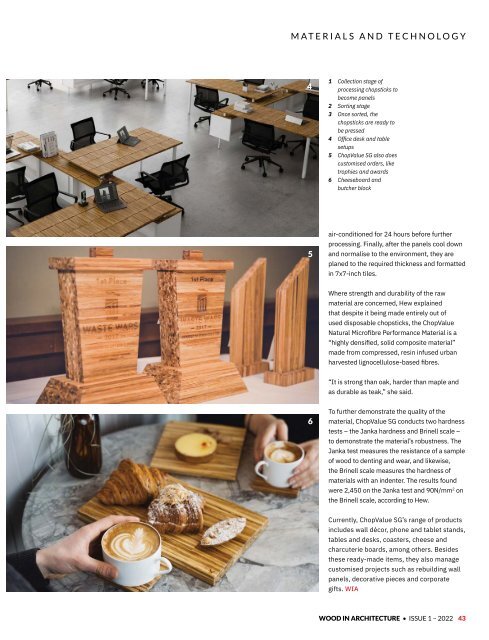Wood In Architecture Issue 1, 2022
First published in 2017, Wood in Architecture (WIA) is a bi-annual trade magazine devoted to the international timber construction sector. The newest addition to the Panels & Furniture Group of wood magazines, WIA features in-depth insights to the latest industry news, incredible projects and leading trade events. WIA is an advocate for timber as a material of choice for today’s built environment, and is the perfect source of inspiration for architects, builders, engineers and interior designers across the globe.
First published in 2017, Wood in Architecture (WIA) is a bi-annual trade magazine devoted to the international timber construction sector. The newest addition to the Panels & Furniture Group of wood magazines, WIA features in-depth insights to the latest industry news, incredible projects and leading trade events. WIA is an advocate for timber as a material of choice for today’s built environment, and is the perfect source of inspiration for architects, builders, engineers and interior designers across the globe.
Create successful ePaper yourself
Turn your PDF publications into a flip-book with our unique Google optimized e-Paper software.
MATERIALS AND TECHNOLOGY<br />
4<br />
1 Collection stage of<br />
processing chopsticks to<br />
become panels<br />
2 Sorting stage<br />
3 Once sorted, the<br />
chopsticks are ready to<br />
be pressed<br />
4 Office desk and table<br />
setups<br />
5 ChopValue SG also does<br />
customised orders, like<br />
trophies and awards<br />
6 Cheeseboard and<br />
butcher block<br />
5<br />
air-conditioned for 24 hours before further<br />
processing. Finally, after the panels cool down<br />
and normalise to the environment, they are<br />
planed to the required thickness and formatted<br />
in 7x7-inch tiles.<br />
Where strength and durability of the raw<br />
material are concerned, Hew explained<br />
that despite it being made entirely out of<br />
used disposable chopsticks, the ChopValue<br />
Natural Microfibre Performance Material is a<br />
“highly densified, solid composite material”<br />
made from compressed, resin infused urban<br />
harvested lignocellulose-based fibres.<br />
“It is strong than oak, harder than maple and<br />
as durable as teak,” she said.<br />
6<br />
To further demonstrate the quality of the<br />
material, ChopValue SG conducts two hardness<br />
tests – the Janka hardness and Brinell scale –<br />
to demonstrate the material’s robustness. The<br />
Janka test measures the resistance of a sample<br />
of wood to denting and wear, and likewise,<br />
the Brinell scale measures the hardness of<br />
materials with an indenter. The results found<br />
were 2,450 on the Janka test and 90N/mm 2 on<br />
the Brinell scale, according to Hew.<br />
Currently, ChopValue SG’s range of products<br />
includes wall décor, phone and tablet stands,<br />
tables and desks, coasters, cheese and<br />
charcuterie boards, among others. Besides<br />
these ready-made items, they also manage<br />
customised projects such as rebuilding wall<br />
panels, decorative pieces and corporate<br />
gifts. WIA<br />
WOOD IN ARCHITECTURE • ISSUE 1 – <strong>2022</strong> 43


















